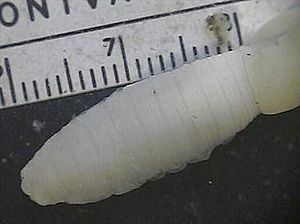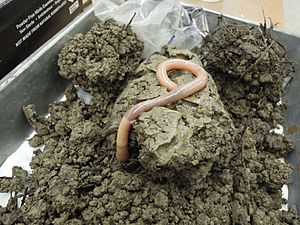Giant Palouse earthworm facts for kids
Quick facts for kids Giant Palouse earthworm |
|
|---|---|
 |
|
| Conservation status | |
| Scientific classification | |
| Genus: |
Driloleirus
|
| Species: |
americanus
|
The giant Palouse earthworm (Driloleirus americanus) is a very special type of earthworm. It is also known as the Washington giant earthworm. This worm lives in the Palouse region. This area is found in eastern Washington and northern Idaho, in the United States.
A scientist named Frank Smith first found this worm in 1897. He found it near Pullman, Washington. These worms can dig very deep into the ground, up to 15 feet (4.6 m)!
For a while, people thought this worm had disappeared. This was in the 1980s. But good news came in 2010! Scientists found two living worms. One was an adult and the other was a young worm. They were found by scientists from the University of Idaho.
About the Giant Palouse Earthworm
Scientists do not know much about the giant Palouse earthworm. Adult worms are usually about 8 in (20 cm) long. They are related to a huge worm in Australia. That worm, the giant Gippsland earthworm, can grow to be 3.3 ft (1.0 m) long!
The giant Palouse earthworm looks albino. This means it is very pale or white. Before it was found again in 2010, people thought it smelled like a lily flower. They also believed it could spit to defend itself. But the worms found recently did not do these things.
This worm's natural home is in the bunch grass prairies of the Palouse region. The soil there is very rich. It has deep loess hills and lots of volcanic ash. It also has many layers of organic matter. This rich soil helps the worm survive during dry times. The earthworm digs deep down in summer droughts. Then, it enters a resting state called aestivation.
Searching for the Giant Palouse Earthworm
In the 1890s, the giant Palouse earthworm was "very common." This was written in an article in 1897 by Frank Smith. Smith's work was based on four worms. These worms were sent to him by R. W. Doane from Washington State University.
No one did a full scientific study back then. So, we do not know how many worms there were. We also do not know how far they spread.
In 2009, a new search project began. Jodi Johnson-Maynard led this project. She is a soil expert at the University of Idaho. Before 2010, only four worms had been seen in 30 years. The last sighting was in 2005. This was by one of Johnson-Maynard's students. Different groups helped pay for this research.
In 2012, two more worms were found. They were found near Paradise Ridge, south of Moscow, Idaho. Cass Davis found one on April 13. Joseph Szasz found another on June 5. Both worms were taken to the University of Idaho for study.
Protecting the Giant Palouse Earthworm
As of 2001[update], the World Conservation Union (IUCN) said the worm was vulnerable. This means it is at risk of disappearing. This is because its home is shrinking. Also, other worms that are not native to the area are competing with it.
In 2006, some groups asked the U.S. government for help. They wanted the worm to be protected under the Endangered Species Act. But in 2007, the U.S. Fish and Wildlife Service (FWS) said no. They said they did not have enough scientific information.
This decision made some environmental groups upset. They sued the FWS. They wanted the worm to get the protection it needed. But in 2009, a court agreed with the FWS. The court said the FWS had good reasons for its decision. They said there was not enough clear proof to list the worm.
In 2009, environmental groups asked again. They filed a new request to protect the worm. But in 2011, the FWS said no again. They said the threats were not strong enough. They did not think the worm was in danger of disappearing soon.



